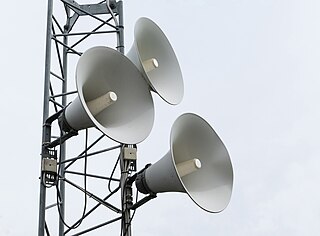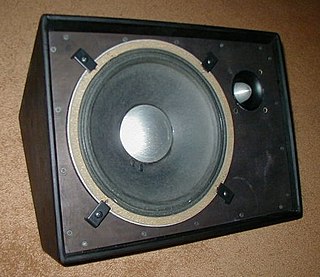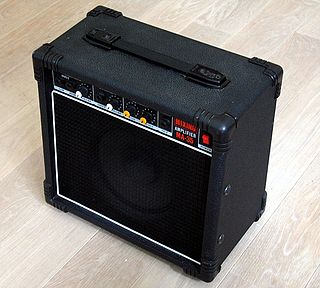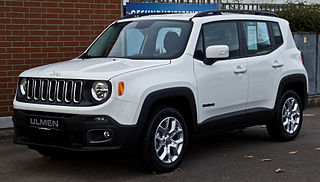The topic of this article may not meet Wikipedia's notability guideline for stand-alone lists .(June 2019) |
Bose has sold various computer speaker products since 1987. Most models consisted of two small satellite speakers, sometimes with a subwoofer.
The topic of this article may not meet Wikipedia's notability guideline for stand-alone lists .(June 2019) |
Bose has sold various computer speaker products since 1987. Most models consisted of two small satellite speakers, sometimes with a subwoofer.

The computer speakers from Bose was the "MediaMate" system, which was released in 1987. The MediaMate included magnetic shielding so that they could be placed near a CRT computer monitor without causing the monitor's image to distort. They had dual inputs and two sources (such as a CD player and a computer game) to be played simultaneously, with a dial to adjust the relative level of the two sources. There is no on/off switch for the MediaMate speakers or any tone controls. [1] Production of MediaMate speakers ended in 2005.
In Japan, the MediaMate was sold as the "MM-1". The MM-1 included an "enhance" function, which basically acted as a tone control.[ citation needed ] An "MM-2" system was also sold in Japan, which included a subwoofer.
The "Companion 2" was released in 2005 as the replacement for the MediaMate. [2] The Companion 2 speakers had two input ports, however (unlike its MediaMate predecessor) there was no control to adjust the level of each source. [3] Virtual surround sound emulation ("TrueSpace Stereo Everywhere") was included. [4]
The "Companion 2 Series II" were introduced in 2006. [5] The appearance changed from round speaker grilles to rectangular speaker grilles.
Compared with the similarly priced M-Audio Studiophile AV20, the Companion 2 speakers were found to have inferior sound quality but the benefit of being able to play two sources simultaneously. [6]
The "Companion 3" system was released in 2003 and consisted of two satellite speakers and a subwoofer. [7] Control is via a wired remote. [8] Dual inputs allow two sources to be played simultaneously, however it is not possible to adjust the relative level of each source.
The "Companion 3 Series II" was introduced in 2006. [9] Changes included smaller satellite speakers with similar appearance to the Companion 5 system and the speaker grille on the subwoofer changing from circular to square shaped. Sales of the Companion 3 Series II ceased in 2016. [9]
The "Companion 5" system was first listed on Amazon in 2004. It was a 2.1 system consisting of two satellite speakers, a subwoofer, a wired control unit and an inbuilt sound card, which connected to the computer via USB. The subwoofer was very similar to that used in the Companion 3 Series II system, however the Companion 5 used larger satellite speakers.
In Europe and Asia-Pacific, a "Companion 50" version of the system was also produced.
The "Companion 20" system was released in 2011 and consists of two satellite speakers and a wired control unit (called "control pod" by Bose). [10] It was discontinued in 2021. [11]

The "Computer MusicMonitor" system was sold from 2007 and consisted of two satellite speakers and a remote control. The Computer MusicMonitor system was judged to have a convenient small size, but sub-standard audio quality for the price. [12] Sales of the Computer MusicMonitor ended in 2017. [13]
In Japan, a similar model called the "Micro Music Monitor (M3)" was released in 2006. The M3 was able to operate on battery power (unlike the Computer MusicMonitor).

A subwoofer is a loudspeaker designed to reproduce low-pitched audio frequencies, known as bass and sub-bass, that are lower in frequency than those which can be (optimally) generated by a woofer. The typical frequency range that is covered by a subwoofer is about 20–200 Hz for consumer products, below 100 Hz for professional live sound, and below 80 Hz in THX-certified systems. Thus, one or more subwoofers are important for high-quality sound reproduction as they are responsible for the lowest two to three octaves of the ten octaves that are audible. This very low-frequency (VLF) range reproduces the natural fundamental tones of the bass drum, electric bass, double bass, grand piano, contrabassoon, tuba, in addition to thunder, gunshots, explosions, etc.

A loudspeaker is a combination of one or more speaker drivers, an enclosure, and electrical connections. The speaker driver is an electroacoustic transducer that converts an electrical audio signal into a corresponding sound.

A home cinema, also called a home theater or theater room, is a home entertainment audio-visual system that seeks to reproduce a movie theater experience and mood using consumer electronics-grade video and audio equipment and is set up in a room or backyard of a private home. Some studies show that films are rated better and generate more intense emotions when watched in a movie theater, but convenience is a major appeal for home cinemas. In the 1980s, home cinemas typically consisted of a movie pre-recorded on a LaserDisc or VHS tape; a LaserDisc Player or VCR; and a heavy, bulky large-screen cathode-ray tube TV set, although sometimes CRT projectors were used instead. In the 2000s, technological innovations in sound systems, video player equipment, TV screens and video projectors have changed the equipment used in home cinema set-ups and enabled home users to experience a higher-resolution screen image, improved sound quality and components that offer users more options. The development of Internet-based subscription services means that 2020s-era home theatre users do not have to commute to a video rental store as was common in the 1980s and 1990s.

Surround sound is a technique for enriching the fidelity and depth of sound reproduction by using multiple audio channels from speakers that surround the listener. Its first application was in movie theaters. Prior to surround sound, theater sound systems commonly had three screen channels of sound that played from three loudspeakers located in front of the audience. Surround sound adds one or more channels from loudspeakers to the side or behind the listener that are able to create the sensation of sound coming from any horizontal direction around the listener.
Nakamichi Corp., Ltd. is a Japanese consumer electronics brand that originated in Japan and gained a name from the 1970s onwards for original and high quality audio cassette decks. Nakamichi is a subsidiary of Chinese holding company Nimble Holdings.

The Chevrolet Avalanche is a four-door, five- or six-passenger pickup truck that was manufactured by General Motors. The Avalanche was a hybrid between the Chevrolet Suburban SUV and the Chevrolet Silverado pickup truck, sharing the chassis with the Suburban. Unlike a typical pickup truck where the bed is mounted separately from the cab on the frame, the bed of the Avalanche was integrated with the cab body.
Bose Corporation is an American manufacturing company that predominantly sells audio equipment. The company was established by Amar Bose in 1964 and is based in Framingham, Massachusetts. It is best known for its home audio systems and speakers, noise-canceling headphones, professional audio products, and automobile sound systems. Bose has a reputation for being certainly protective of its patents, trademarks and brands. The majority owner of Bose Corporation is the Massachusetts Institute of Technology. Non-voting shares were donated to MIT by founder Amar Bose and receive cash dividends. The company's annual report for the 2021 financial year stated that Bose Corporation's yearly sales were $3.2 billion, and the company employed about 7,000 people.

A public address system is an electronic system comprising microphones, amplifiers, loudspeakers, and related equipment. It increases the apparent volume (loudness) of a human voice, musical instrument, or other acoustic sound source or recorded sound or music. PA systems are used in any public venue that requires that an announcer, performer, etc. be sufficiently audible at a distance or over a large area. Typical applications include sports stadiums, public transportation vehicles and facilities, and live or recorded music venues and events. A PA system may include multiple microphones or other sound sources, a mixing console to combine and modify multiple sources, and multiple amplifiers and loudspeakers for louder volume or wider distribution.

A sound reinforcement system is the combination of microphones, signal processors, amplifiers, and loudspeakers in enclosures all controlled by a mixing console that makes live or pre-recorded sounds louder and may also distribute those sounds to a larger or more distant audience. In many situations, a sound reinforcement system is also used to enhance or alter the sound of the sources on the stage, typically by using electronic effects, such as reverb, as opposed to simply amplifying the sources unaltered.

Computer speakers, or multimedia speakers, are speakers sold for use with computers, although usually capable of other audio uses, e.g. for an MP3 player. Most such speakers have an internal amplifier and consequently require a power source, which may be by a mains power supply often via an AC adapter, batteries, or a USB port. The signal input connector is often a 3.5 mm jack plug ; RCA connectors are sometimes used, and a USB port may supply both signal and power. Battery-powered wireless Bluetooth speakers require no connections at all. Most computers have speakers of low power and quality built in; when external speakers are connected they disable the built-in speakers. Altec Lansing claims to have created the computer speaker market in 1990.

Sound Blaster Live! is a PCI add-on sound card from Creative Technology Limited for PCs. Moving from ISA to PCI allowed the card to dispense with onboard memory, storing digital samples in the computer's main memory and then accessing them in real time over the bus. This allowed for a much wider selection of, and longer playing, samples. It also included higher quality sound output at all levels, quadrophonic output, and a new MIDI synthesizer with 64 sampled voices. The Live! was introduced on August 11, 1998 and variations on the design remained Creative's primary sound card line into the early 2000's.

A stage monitor system is a set of performer-facing loudspeakers called monitor speakers, stage monitors, floor monitors, wedges, or foldbacks on stage during live music performances in which a sound reinforcement system is used to amplify a performance for the audience. The monitor system allows musicians to hear themselves and fellow band members clearly.
KEF is a British company specialising in the design and production of a range of high-end audio products, including HiFi speakers, subwoofers, architecture speakers, wireless speakers, and headphones. It was founded in Maidstone, Kent, in 1961 by a BBC engineer named Raymond Cooke (1925–1995). In 1992, the Hong Kong–based Gold Peak Group acquired KEF; and GP Acoustics, a member of Gold Peak, now owns the company. KEF continues to develop and manufacture its products in Maidstone.

A keyboard amplifier is a powered electronic amplifier and loudspeaker in a wooden speaker cabinet used for the amplification of electronic keyboard instruments. Keyboard amplifiers are distinct from other types of amplification systems such as guitar amplifiers due to the particular challenges associated with making keyboards sound louder on stage; namely, to provide solid low-frequency sound reproduction for the deep basslines that keyboards can play and crisp high-frequency sound for the high-register notes. Another difference between keyboard amplifiers and guitar/bass amplifiers is that keyboard amps are usually designed with a relatively flat frequency response and low distortion. In contrast, many guitar and bass amp designers purposely make their amplifiers modify the frequency response, typically to "roll-off" very high frequencies, and most rock and blues guitar amps, and since the 1980s and 1990s, even many bass amps are designed to add distortion or overdrive to the instrument tone.

The Jeep Renegade is a subcompact crossover SUV produced by Stellantis under their Jeep marque. It was first shown to the public in March 2014 at the Geneva Motor Show and production started in late August of that year. The Renegade was the smallest vehicle currently marketed by Jeep, until the arrival of the Avenger. It slots between the Avenger and the Compass. It is based on the FCA Small Wide 4×4 platform which is also shared with other FCA models, including from Fiat and Alfa Romeo brands.
Apple Inc. has produced and sold numerous music and multimedia speakers, available for standalone purchase and bundled with Macintosh products.

SoundSticks are multimedia speakers sold by Harman Kardon, originally co-developed with Apple Inc. They were released in July 2000. They are a 2.1 system with a pair of satellite speakers and a subwoofer called the iSub, which was originally available first in October 1999 as a standalone product. They were designed by Jony Ive and have received numerous accolades for their industrial design. Harman Kardon released updated versions in 2004, 2009, 2012 and 2020.